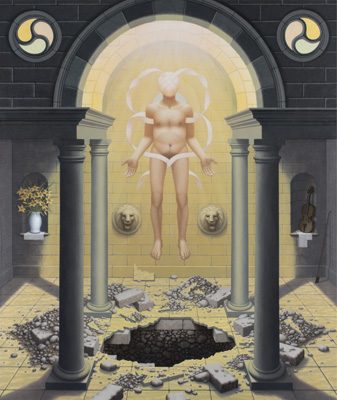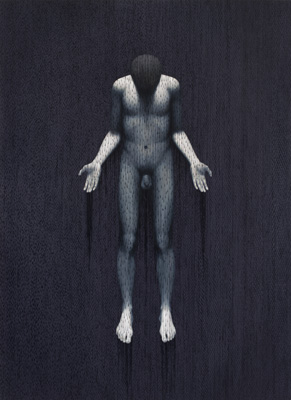
 |
| Resurrection 2007/2011, acrylic on canvas 78 x 66 in. |
Resurrection |
One of the wonderful things about a work of art is that it is filtered though the mind of the viewer and as such is read through that unique lens. The result is a vast array of readings that do not necessarily parallel the artist's intentions. In my mind that result is okay because it is natural to do so, it enriches the viewing experience, and it opens up new and exciting meanings for the work. Like all other works of art, Resurrection can be read in a variety of ways. This essay will discuss three of them. The first, and I think the most common, is a purely descriptive reading. Overall the painting depicts the interior of a room with a nude male figure prominently located in the middle of the image. The figure floats in the air with his head hidden underneath a wrapping of white cloth. The cloth extends from the top of his head and then streams down and around the figure creating a figure-eight shape. Directly beneath the figure is a hole in the floor. Scattered around the hole are various forms of debris like dirt, rocks, and bricks. This suggests the figure and the debris came from the hole and as such implies that the room is a mausoleum of some sort. Supported by four columns is a clerestory from which light emanates. The light bathes the room in a yellow-golden color and illuminates two circular windows located in the upper corners of the canvas. On the back wall of the room are two niches. One contains a bouquet of star-shaped flowers in a vase while the other contains a violin. Each of these objects rests on a white cloth. The bow of the violin stands at an angle on the floor and is propped up against the sidewall beneath the niche with the violin. Also on the back wall are two lion-head sculptural reliefs. The second is a formal reading, which explores the formal artistic aspects of the piece. Unlike many of my other works Resurrection explores the use of a natural illusionistic space using perspective and a ground/horizon/sky relationship. This method is used to depict the interior of a mausoleum that is divided into three major sections – an upper hidden space from which the light source emanates; the main mausoleum space; and a dark burial space below. Using this kind of tangible earth-bound space provides the perfect setting for the introduction of a magical element – a floating figure that defies gravity. The relationship between the two heightens the basic nature of each – the architecture becomes more grounded and the floating figure lighter. Resurrection is also primarily a symmetrical composition. The only exceptions are the flower vase/violin relationship, and the scattering of dirt, rocks, bricks, and broken tiles. These variations serve to break the rigidity of the symmetry and add visual interest. The color palette is limited to muted yellows, gray, and a few hints of light blue, brown and pink. This tends to unify the image and heighten its overall feel. The perspective vanishing point is intentionally located at the center of the figure thereby drawing the viewer's eye to the figure making it the center of attention. |
 2007/2011, acrylic on canvas, 78 x 66 in. |
 2005, acrylic on canvas, 66 x 48 in. |
The third and final reading is about the symbolism and references I have used in the painting. They include general and religious symbols and references as well as references to other works of mine. The title Resurrection is, by itself, a reference. In this context it is used in a non-specific way but it can refer to the general concept of resurrection found in most religions. The pose of the figure is meant to express a state of openness and acceptance - a state of grace. I have explored the use of this pose in several other paintings, notably Light of the Dead (2002), Cleansing the Invisible Man (2005), and more recently in Caught in the Crossfire (2018-2019). The perspective vanishing point I mentioned before is located at the figure's solar plexus. This location symbolically references the solar plexus chakra of various eastern religions and meditative practices. It is often referred to as the seat of the ego and is related to the sun, and therefore often represented by the color yellow. As such I have chosen yellow as the dominant color in the painting. The ribbons streaming around the figure form a figure eight, which is a symbol for eternity. This references the resurrection of the body to eternal life. The two circular windows in the upper corners of the painting are based on a combination of the Gothic trefoil window design and a variation of the triple yin yang symbol or gankyil (wheel of joy) used in Tibetan Buddhism. In the context of the painting the windows can be seen as physical windows that radiate the light of God, referencing the rotating wheel of the birth/life/death triad, as well as a symbol for the joy of resurrection. The vase of flowers symbolizes the beauty of nature and life while the violin symbolizes the beauty of music. The lion head sculptural reliefs act as guardians of the crypt or protectors of the dead. The four columns or pillars that hold up space where the light of God resides can be viewed as representing the four noble truths of Buddhism. As such the figure can be seen as being simultaneously resurrected in the Christian sense, as well as awakened or liberated in the Buddhist sense. As I mentioned earlier, Resurrection, like any work of art, can have multiple readings. Though I have not exhausted the content of the three readings I have discussed here I hope this short essay inspires the viewer to continue the exploration of other possible readings in this and other works of art. - Brian Mains, January 2020 |